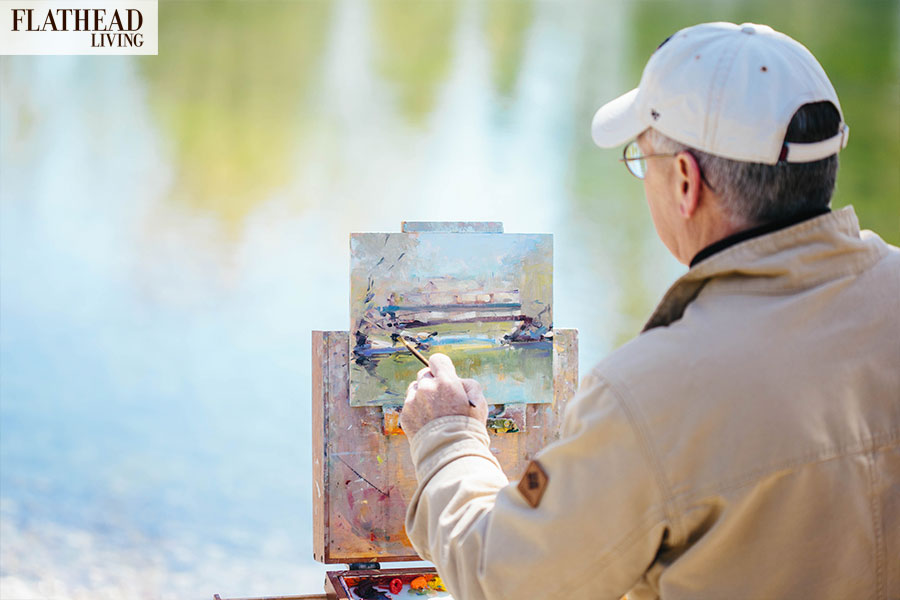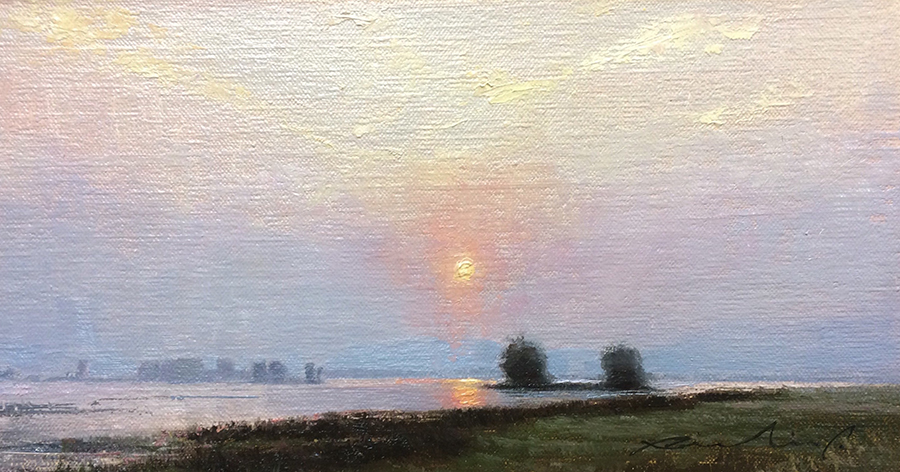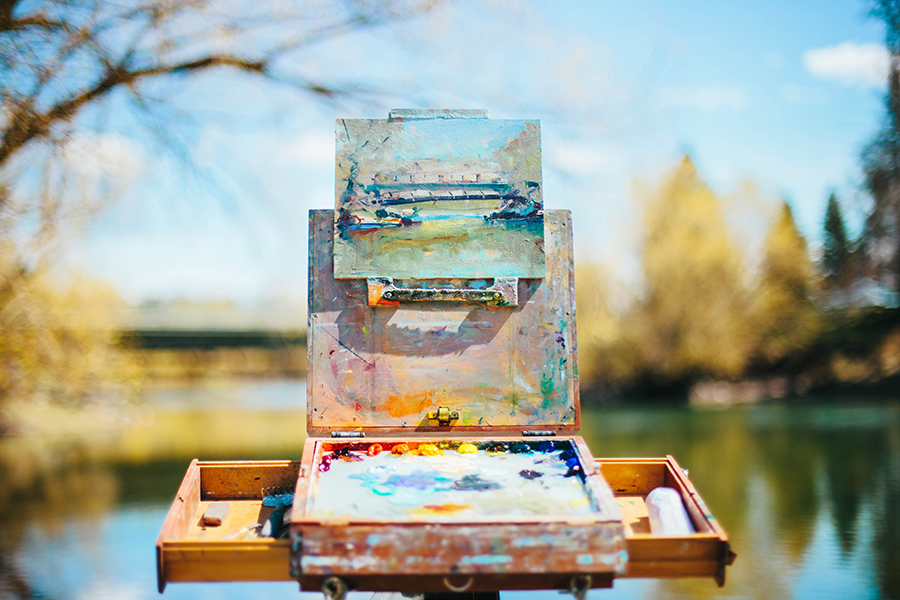Plein to See
Flathead Valley painters, from amateurs to pros, paint “en plein air” to experience the wonder of Northwest Montana
By Clare Menzel
Derek Vanderberg bends over a tablet, scrolling through the Frame of Reference fine art gallery archives to find the image of “Ninepipes,” a 6-inch-by-12-inch painting that sold for $675 last year. He holds it up, so I can compare it to “Bleeding Light,” a framed 19-inch-by-35-inch painting hanging on the wall, listed for $3,400. Kalispell-born oil painter Richie Carter made these two versions of the same sunset over Ninepipes Wildlife Refuge. A pinprick-sized wildfire sun burns through the center of the canvas. Around it, evening sky fades softly from indigo to pale rose to light yellow. He painted the smaller sketch onsite, working quickly to capture the emotional notion of the composition. The larger painting came later, after assiduous hours in the studio.
“There’s a level of refinement,” Vanderberg explains, nodding at the wall. In the studio work, Carter achieved subtler transitions in the diffuse light’s coloring, and he fleshed out some details in mountains and trees.
“This one,” Vanderberg says, gesturing back to the tablet, “it’s raw in comparison … It’s capturing a moment, rather than polishing and engineering a moment … There’s a realness to it, a sense of connection.”
Vanderberg emphasizes that neither is better; plein air and studio painting strive for different artistic goals. En plein air, meaning “in open air,” describes art works completed outdoors and in one session. French painters like Claude Monet and Pierre-Auguste Renoir developed the tradition in their impressionistic style. The goal is not to render the scene in photographic perfection. Chasing that flawlessness would take too much time onsite. And, more importantly, preoccupation with detail would obstruct the artist’s ability to express their unfiltered emotional experience in a fixed time and place.
Many of the artists Vandeberg shows love to paint onsite, he says. This is the legacy of landscape artists in Northwest Montana, home to the infinitely paintable Glacier National Park. Last year, Kalispell’s Hockaday Museum of Art celebrated a decade of the Plein Air Glacier Paint-Out, an annual Plein Air magazine-sponsored event. Invited painters venture into the park with their brushes and easels for one week in mid-June, and then, for the grand finale, present their work in a collaborative show. May through August this year, the museum is also hosting an exhibition of artworks created by members of the prestigious Plein Air Painters of America during plein air sessions in fall 2018.
“Plein air painting is traditionally a learning tool, for understanding light and landscape. But it has become more of a consumer project,” says 29-year-old Kenneth Yarus, a contemporary of Carter, who is 30. Both of their work hangs in Frame of Reference, as well other galleries across the West. “I can’t help but learn when I’m plein air painting, but sometimes I get lucky [and can sell the study].”
“It’s vital for me to go out,” Yarus continues. “It makes me feel — not to be spiritual — but, more tapped into what’s important in a place.”
Carter says, for him, plein air isn’t about making a work to sell. “I just want to be out, experiencing the landscape.” Like Yarus, he notes that this practice is “essential” for him as an artist.
“We’re used to snapping a million photos [of a landscape] before we even look at it, or care,” Carter says. Plein air, by contrast, asks the viewer to sink in. “Our [millennial] generation really does appreciate that slowing down,” he continues. “We’re becoming aware that the culture we’ve gotten into is maybe not the healthiest. We all do want more genuine connection.”

Kathleen Schlabach, a 29-year-old Wisconsin-born painter, describes her practice of plein air as “translating an experience.” Schlabach sells her oil paintings under the name High Rockies Art. With her pup, Ollie, trotting alongside, Schlabach hikes into the Mission and Swan Mountains to paint en plein air. After walking all day, she’ll establish her camp, then find someplace to perch and paint the golden light of summer’s late sunsets.
“You’re taking the time to really recognize how beautiful these sculptures — the mountains — are,” she says. “You’re so much more aware … I think it’s really good for a business, for art, for the soul, to bring a project with you when you’re backpacking.”
A number of local landscape painters have been moving oil around on canvas outdoors since the ‘70s. Back then, says 66-year-old artist Mark Ogle, “we just called it, ‘Let’s go outside and paint.’ But then they had to coin a fancy word for it.” Ogle and his late mentor, Joe Abbrescia, were part of a small group who realized that they “couldn’t afford to not go outside” to paint.
“To get accurate color, an accurate envelope of atmosphere … you get outside,” Ogle says. “It only comes outside.”
Ogle showed me around his studio and gallery in downtown Kalispell, pointing to piece after piece that he painted outside, and noting the similarities: “An outdoor piece usually has very fresh, loose strokes of paint … You’ll see almost a cool [color] harmony to the piece,” due to the atmosphere. He calls this the plein air “cool veil.” Studio paintings, produced under artificial light, often trend warmer.
Other fine artists use plein air as respite from their usual work. Whitefish artist Nancy Cawdrey, 70, who was included in the Hockaday museum’s 2016 exhibit “A Timeless Legacy – Women Artists of Glacier National Park,” is well-known for her silk painting. She’ll occasionally use a plein air sketch as a study, and she’s participated in the Hockaday Paint Out, but her plein air is most often an end in itself.
“It’s one of my very favorite things to do,” she says. “I get the oil on as quickly as I can, and leave it as clear and simple as I can … It’s not a perfect medium. It’s not realism for me at all. It’s the idea of light and air and gesture and the artistic response to nature.”

Oil painter Rob Akey is squinting on the banks of the Whitefish River. He strokes paint onto his 12-inch square canvas. River and sky take shape.
“This is just ‘massing in,’” he says. “The big shapes — I’m ‘scrubbing in.’”
At this early stage in a plein air painting, Akey explains, it’s extremely important to squint, to abstract the scene into its shapes and its values — the lights and darks.
“My eyes are really drying out,” he says, blotting his brush with a bit of paper towel from the roll wedged in the crook of his elbow. “I picked a stupid spot; I’m staring into the sun.”
Akey, 62, is president of Montana Painters Alliance, Hockaday Board Vice President, and a grandfathered-in artist of the museum’s Paint Out. He grew up in Whitefish, and when he was in high school, the museum in Kalispell was just emerging. Akey says the institution was one of the “sparks” for him to pursue art “as a legitimate career.” He earned a degree in design and illustration from Minneapolis College of Art and Design, and then found work as the creative director for Tonka Toys, to pay off art school bills. After a decade, he left to pursue fine art full-time. That was 14 years ago, and now Akey’s work hangs in Dick Idol Signature Gallery, as well as four others across the state. Though the national park is a peerless backdrop, Akey also loves to paint en plein air downtown, on Central Avenue, and he’s especially fond of a piece he made of the moonlight alley near his Whitefish studio on a snowy night.

“In Montana, people are buying more non-Western art subjects,” he says, which includes what he describes as “pavement paintings.” In his Whitefish River scene, he’s including the Baker Street bridge, streetlights, and a few houses partially obscured by foliage. People will relate to these landmarks, he explains, which will help them better understand the moment that the piece represents. Akey describes art as an exchange that happens between the artist and the viewer. With a painting, the artist is just suggesting.
“It completes itself in the mind of the viewer,” he says. He also tells me “it’s like fishing. Sometimes you go, and you don’t catch.”
After Akey finishes composing the general structure of the piece with masses of color, he layers in detail: tree branches, hard edges, some “dark darks and super light lights.” He leaves his brush strokes visible. A bug flies into the daub of cobalt on his easel.
“I don’t think there are any other forms of creating a painting that are more challenging than standing out here shivering, slapping bugs, people coming up and saying, ‘Don’t quit your day job,’” Akey says. “But, the achievement is great.”
Akey feels that some of his best paintings were done outdoors. One of his most memorable is of the Highline Trail in Glacier Park, which he completed in less than a half hour. While working on a different painting at Sun Point, on the north shores of St. Mary Lake on the east side of the park, the head of the lake suddenly turned black. He could see whitecaps. But he was so pleased with how the painting was going that he kept working as the storm marched down the lake. He got drenched. The painting sold.
Stepping back to regard his Whitefish River sketch, he says, “I kinda like where this is right now.” He rests the brush on his easel. Later, in his studio, Akey touches it up with “embellishments,” and the following day, he sends me an email with an image of the final piece attached. When the photo downloads, art happens.

Graphic designer and amateur plein air painter Collin Hamman and I have plans to meet at Blanchard Lake to paint from his red canoe after his workday is over. Around 4 p.m., dark clouds crowd the sky, but we meet anyway. We’d attempted to do this the day before, but unruly wind on Whitefish Lake pushed us back to shore. If the light on Blanchard isn’t well-suited for painting, Hamman’s fly-fishing rod is propped in the stern.
He sets up his easel, a homemade, dual-purpose contraption that flips up into a painting surface, and also folds down to rest snugly on the gunwales, forming a casting platform. For both painting and fly-fishing, “observing the water is a big part of it,” he notes. “I try to link the two as much as possible. It’s observational exercise.”
It’s gusty, so Hamman drops his anchor and lets the breeze situate his boat. It spins us so the sun is at our backs. Plein air painters often talk about the difficulty of selecting an appropriately sized and complete composition from the vast panorama available. Hamman looks out in front of him, dips his brush, and says, “Well, I guess I’ll paint that house.”
Hamman is a screen-printer and designer for Whitefish-based Montana Shirt Co., and he also works as a freelance illustrator. In contrast to his typical meticulous, laborious, fine-lined illustrations, plein air is “real and here and now.”
“Plein air, for me, is an escape from commercial art and a chance to recharge and appreciate nature without the pressure of income,” he says. “I’m constantly torn between, ‘I should go outside and get inspiration,’ and, ‘I should stay inside and draw [for work].’”
Within the hour, the other fishermen on Blanchard pack it in for the evening, and we’re close to following suit when we realize that the moody cloud behind us is about to move off the sun. Hamman stows his painting and snaps the easel into fishing mode. When the cloud clears, the sun is low in the sky and warm light fans over the lake. The wind has died. As Hamman casts and casts overhead, flecks of water fly through the sunset rays. And then, just as quickly as this enchanted moment arrived, it’s over. The sun drops behind the hills, and the light is gone.
Read more of our best long-form journalism in Flathead Living. Pick up the spring edition for free on newsstands across the valley, or check it out online at flatheadliving.com.